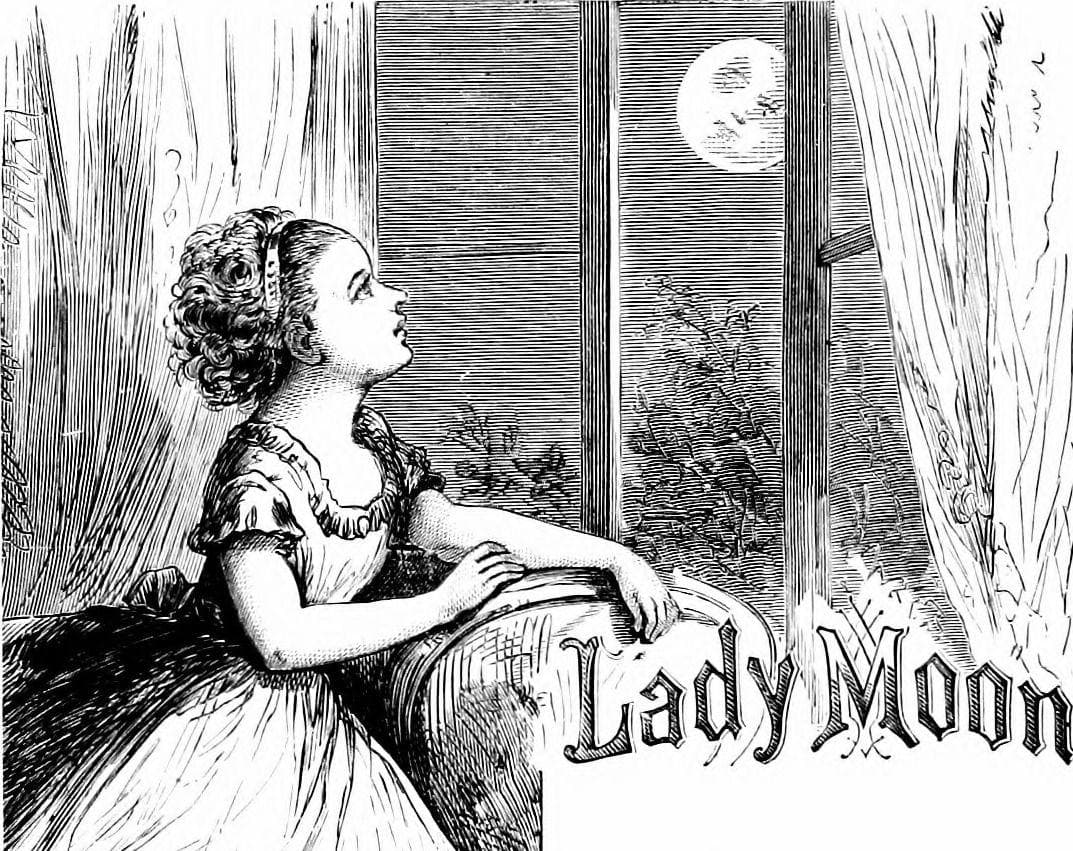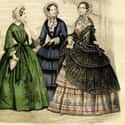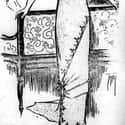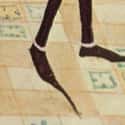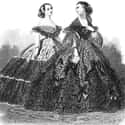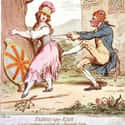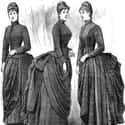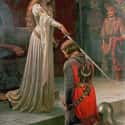-
(#1) Lotus Shoes
Lotus shoes were worn by Chinese girls with bound feet. For centuries, families repeatedly broke and folded the feet of their young daughters to create the tiny feet that epitomized femininity. The foot was bound with long ribbons to prevent growth. If the toes withered and fell off, even better. The process usually took between two to three years, and the girl’s feet were bound for the rest of her life.
Women with bound feet wore Lotus shoes, cone or sheath-shaped footwear that resembled a lotus bud. The shoes were made of silk or cotton and were usually ornate, embroidered with flowers, animals, and other traditional patterns.
There were many attempts to ban foot binding throughout history. It was officially outlawed in 1912, though the practice was still carried out in secret in some areas of China for years after.
-
(#2) Arsenic Dresses
Bottle-green dresses were all the rage in the Victorian era, and they had price tags to match. To achieve this lovely shade of green, the fabric was dyed using large amounts of arsenic. Some women suffered nausea, impaired vision, and skin reactions to the dye. But the dresses were only worn on special occasions, limiting exposure to the arsenic in the fabric.
The garment makers were the real sufferers - many died to bring this trend to the fashionable set.
-
(#3) Codpieces
15th and 16th century men sought to accentuate their packages with codpieces. They were often made of padded cloth or embroidered fabric, though metal codpieces were also worn. Held in place with buttons, strings, or ties, the codpiece was designed to draw praise and raise a man’s profile. Even the name was knowingly bawdy - "cod" was slang for scrotum.
But French philosopher Michel de Montaigne wasn’t having it, calling out the hypocrisy of the device. In the 1580s, he deemed the codpiece "an empty and useless model of a member that we cannot even decently mention by name, which however we show off and parade in public."
Codpieces eventually fell out of fashion as doublet styles changed and breeches became more billowing.
-
(#4) Hobble Skirts
In the 1910s, French designer Paul Poiret - dubbed "The King of Fashion" in America - debuted the hobble skirt. The long, close-fitting skirts forced women who wore them to adopt mincing, tiny steps. True, Poiret's design liberated women from heavy petticoats and constricting corsets.
But as he said, "Yes, I freed the bust. But I shackled the legs."
-
(#5) Crakowes
Also known as the poulaine, this super long shoe reigned supreme with men across Europe in the late 14th century. The shoes were named after Krákow, Poland because they were introduced to England by Polish nobles. Once the shoes were seen at court, they became all the rage - even though the shoes were six to twenty-four inches long. But they were a quick indicator of social status: the longer the shoe, the higher the wearer's station.
Chains were sometimes strung from the toe of the crakow to the knee to allow the wearer to walk. Sometimes the toes were stuffed with material for the same reason. They were considered ridiculous, vain, and dangerous by many conservatives and church leaders, who called them "devil's fingers."
-
(#6) Breast Flatteners
During the Roaring '20s, the hourglass shape gave way to the boyish flapper figure and underwear got an overhaul. The goal of every undergarment was to flatten the breasts and torso, so that flapper dresses could hang straight down without any curvaceous interruptions.
Corset-makers R. & W.H. Symington invented a garment, the Symington Side Lacer, that would flatten the breasts. The wearer would slip the garment over her head and pull the straps and side laces tight to smooth out curves. Other manufacturers designed similar devices. The Miracle Reducing Rubber Brassiere was "scientifically designed without bones or lacings," while the Bramley Corsele combined the brassiere and corset into one piece that easily layered under dresses.
-
(#7) Panniers
Panniers (from the French word "panier," meaning "basket") were popular in the 17th and 18th centuries. The boxed petticoat expanded the width of skirts and dresses, and stood out on either side of the waistline. Panniers varied in size and were made of whalebone, wood, metal, and sometimes reeds. Extremely large panniers were worn mostly on special occasions and reflected the wearer’s social status. Servants wore smaller hoops. Two noblewomen, however, couldn’t walk through an entrance at the same time or sit on a couch together. The device was also uncomfortable, limiting movement and activity.
The expansive pannier sparked ridicule. A satirical article in The Gentleman’s Magazine, written in 1750, portrayed women as being sick of the burden of the style. "We pass along, as it were, balancing between two scales. Every person we meet, every post we pass, and every corner we turn, incumber [sic] our way, and obstruct our progress. We fit in a chair hid up to our very ears on either side, like a swan with her head between her lifted wings. The whole side of a coach is hardly capacious enough for one of us," a passage read.
-
(#8) Stiff Starched Collars
These detachable collars were popular in the 19th century, and they could be deadly. Starched to the point of being nearly unbendable and attached with a singular or pair of studs, the collar could slowly asphyxiate a man, particularly if he fell asleep or passed out while drinking.
Another dangerous aspect of the collar was its pointed corners. A St. Louis man tripped in the street and the pointed corners of the collar jabbed into this throat, "making two ugly gashes." These collars were so lethal, in fact, that they were known as "the father killer."
-
(#9) Crinolines
The crinoline, also known as the hoop skirt, was a bell-shaped device that pushed the volume of skirts to an extreme degree. Worn in the 1800s by Victorian women, crinolines were originally petticoats made of linen stiffened with horsehair. Later, the invention of the steel cage crinoline offered the same voluminous look without the extra heat and bulk of thick petticoats.
These undergarments were unwieldy, but they were also dangerous. In 1858, a young woman in Boston died when her large skirt caught embers from a fireplace in her parlor and went up in flames. Nineteen such deaths occurred in a two-month period.
-
(#10) Macaroni
In the 1760s, aristocratic British men donned large wigs with a small hat or feather at the top. The young men who took up this fashion trend reportedly brought it back from their "Grand Tour" across Continental Europe in which they intended to "deepen cultural knowledge." The style is, in fact, named after the Italian pasta dish, signifying sophistication and worldliness.
In the popular rhyme, "Yankee Doodle," the British would sing:
Yankee Doodle went to town
A-riding on a pony,
Stuck a feather in his cap
And called it macaroni.The lyrics were meant to satirize the idea that any commoner could stick a feather in his hair and consider himself as valuable as "macaroni." Regardless of the rhyme, however, the style became a trend, and lived on well into following decade.
-
(#11) Corsets
Corsets have been around in one form or another since the 5th century. They were originally made of stiffened fabric, and then evolved into cage-like contraptions made from whalebone, wood, or steel. Corsets caused organs to shift around, and caused indigestion and constipation - but they weren't deadly.
There’s a lot of misinformation about the corset, as Valerie Steele, the director and chief curator of the Museum at the Fashion Institute of Technology, explains. "Most people today think corsets were extremely dangerous and caused all kinds of health problems, from cancer to scoliosis," Steele says. "And that’s quite inaccurate. Most of the diseases that have been credited to corsets, in fact, had other causes. Corsets did not cause scoliosis, the crushing of the liver, cancer, or tuberculosis. It doesn’t mean that corsets were without any health problems, but it does mean that most modern people are wildly naive in believing the most absurd antiquated medical accusations about corsetry."
-
(#12) Chopines
In the 16th century, noble ladies were mad for the extreme platform shoes known as chopines. They were made mostly from wood or cork covered in leather, brocade, or jewel-embroidered velvet. These shoes were worn as a sign of one’s social status, with higher shoes meaning a higher standing.
Chopines made the wearer wobbly on their feet. Women would sometimes require assistance to venture out in their extra tall shoes.
-
(#13) Bombasts
The exaggerated body stuffing known as bombast was popular with both women and men during the 16th century. Cotton, wool, or even sawdust was used to add volume to areas of clothing, particularly the sleeves.
Men sometimes filled their doublets to give the illusion of a fuller belly, or padded their calves to look more muscular.
-
(#14) Bustles
Also known as the "Grecian bend," the Victorian bustle arrived on the scene in the 1870s. The earliest version of this trend simply featured excess fabric gathered and draped at the back of a dress. Eventually, though, skirts were puffed up with large cushions filled with straw. Ladies who wore them ended up with exaggerated figures with outthrust hindquarters.
The bustle was frequently a target of ridicule. In 1868, Laura Redden Searing - using the pen name Howard Glyndon - wrote about the agony young women put themselves through for fashion in the New York Times, "If you knew the Spartan courage which is required to go through an ordeal of this sort for two or three hours at a time, you would not wonder that she has not an idea left in her head after her daily display is over," she said.
-
(#15) Bloomer Suits
Newspaper editor and temperance advocate Amelia Bloom helped start a of wave of more practical, less constricting clothing in the 1850s. Her temperance newspaper, The Lily, became the place where she and writer and activist Elizabeth Smith Miller promoted the "Bloomer suit." Consisting of trousers under a knee-length skirt with a vest, the Bloomer suit caught on with temperance activists and other like-minded women, causing a major sensation.
Women who wore Bloomer suits were frequently harassed, as the outfit was deemed scandalous. Many in the press and society lamented that the Bloomer suit robbed a woman of her mystery by revealing too much. The Bloomer suit was eventually ridiculed back into the closet, but not before making a mark on fashion.
-
(#16) Muslin Dresses
Popularized by Marie Antoinette, the muslin dress was sheer and quite risqué. It embodied a new age at French court where women showed off more skin - but it was dangerous to wear in the dead of winter, since the thin fabric offered little insulation. Rumor had it that some women even wet down the dress with perfumes or water to show off their figure, further exposing themselves to the elements.
Some historians believe the muslin dress lead to the 1803 influenza outbreak in Paris. Many women died of the so-called "muslin disease."
-
(#17) Bliauts
In the 12th century, European men and women wore this ornate garment with floor length-sleeves. The bliaut or bliaud is a word from the Old French with Germanic origins, and is the root word of the modern "blouse." The bliaut’s most notable features were its extremely long sleeves, which looked dramatic but likely hindered movement. Most bliauts were made of wool, but silk was also a favorite fabric.
The garment’s exact origin isn’t known, but historians think the bliaut made its way to Europe during the Crusades.
New Random Displays Display All By Ranking
About This Tool
Even the most fashionable people cannot withstand the impact of some of the stupidest fashion trends in history. Some fashion trends are not only so silly but dumb, some of these trends have even become a symbol of the culture of the times. From the Lotus Shoes in feudal China to the Arsenic Dresses popular in ancient Europe, these dumbest fashion trends are so absurd by today's standards that we can't help laughing and wondering what people were thinking at the time.
We can clearly know that fashion trends are closely related to society and culture. The random tool shows 17 pictures of the dumbest fashion trends in world history that you will be interested in.
Our data comes from Ranker, If you want to participate in the ranking of items displayed on this page, please click here.

